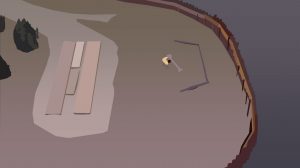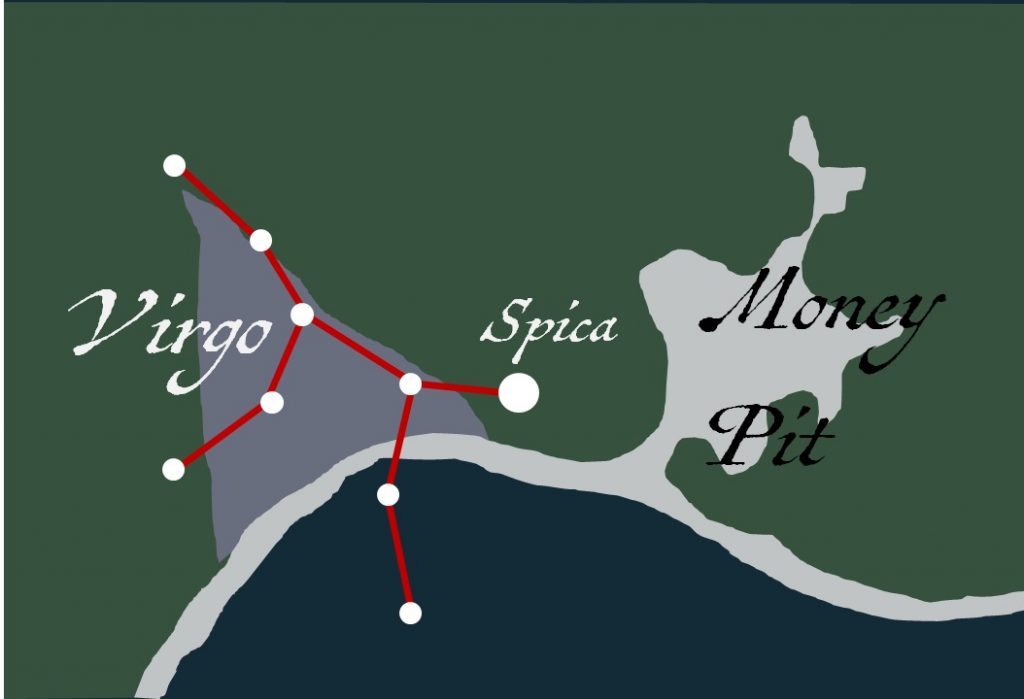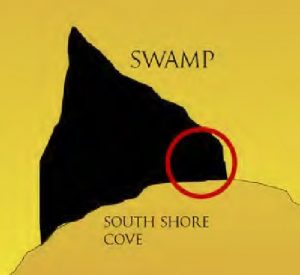The Curse of Oak Island: Season 6, Episode 21- Seismic Matters
The following is a Plot Summary and Analysis of Season 6, Episode 21 of the History Channel’s TV series The Curse of Oak Island.
[SPOILER ALERT!]
Plot Summary
Craig Tester, Rick Lagina, and Marty Lagina, the latter in attendance via video conference, meet in the War Room to discuss their plans for the immediate future in light of recent news that the workers’ strike will likely last the full 21 days. Marty suggests that they finish up the excavation at Smith’s Cove, then “take a long deep breath” and decide whether or not to pack it in for the season. Craig and Rick both agree with the first part of Marty’s proposal but have different ideas regarding the second, Craig being in favour of wrapping up after the work at Smith’s Cove is concluded and Rick expressing a desire to continue working on the island for as long as the weather permits. Marty agrees with his elder brother, saying “I want to do everything we possibly can this year because… we’ve been at this for a long time, we’re not getting any younger… for right now, though, I feel like ‘let’s do it all’, and even if that includes resurrecting that damned swamp.” Rick and a seemingly reluctant Craig concur on the provision that the rest of the team members are “on board”.

Later, Rick Lagina, Gary Drayton, Laird Niven and Terry Matheson watch as Billy Gerhardt excavates the area of the old Smith’s Cove crane pad with a backhoe. It is revealed that, aside from the recently-discovered Restall shaft and the underground wall dug up in Season 6, Episode 19, little of interest has been found in the area or in its washed and scrutinized spoils. While the treasure hunters chat, Gerhardt unearths a wooden board which proves to be part of another subterranean shaft. “If structures were treasure,” jokes Drayton, “we’d be rich”.
After the narrator reveals that the crew plans to conduct a seismic survey in the Oak Island swamp, we see the crew congregated in the War Room, where theorist Chris Donah has come to deliver a presentation. Donah tells the crew members that he believes the depositors of the Oak Island treasure used boulders and other markers to create an astronomical map on Oak Island. After the narrator reminds us of similar theories- namely Travis Taylor’s star map theory and Petter Amundsen’s theory regarding Nolan’s Cross, which was introduced back in Season 1, Episode 4- Donah begins talking about the Royal Arch- an important symbol of Freemasonry associated with a particular Freemasonic degree. This symbol depicts a stone archway consisting of a seven-piece arch resting atop two pillars, each piece of the arch representing a particular constellation.
Donah goes on to suggest that the depositors of the Oak Island treasure associated Oak Island’s triangular swamp with the constellation Virgo, and considered the star Spica, which represents the hand of Virgo, to be of special significance. When Donah overlays the constellation Virgo on a map of the swamp, the star Spica is located in the swamp’s southeast corner. There, Donah believes the treasure hunters will find a “back door” to the Money Pit.

 In response to Donah’s presentation, Rick discloses that, at the southeast corner of the swamp, the treasure hunters discovered a huge flat stone, the surface of which he describes as being as level as the War Room table.
In response to Donah’s presentation, Rick discloses that, at the southeast corner of the swamp, the treasure hunters discovered a huge flat stone, the surface of which he describes as being as level as the War Room table.
Later, Rick Lagina, Craig Tester, and Dave Blankenship meet at the freshly-drained Oak Island swamp with members of geophysical survey company Eagle Canada, who conducted the seismic survey of the Money Pit and Mega Bin areas in Season 6, Episodes 1 and 2. The seismic crew members outline their plan for the upcoming seismic survey, explaining that they intend to use 2,025 dynamite charges and 4,000 geophones in the operation.
Later, Marty Lagina and Gary Drayton head to Oak Island’s Lot 27, where muck from the recently-drained swamp has been transported. Marty spreads some of the mud out with a backhoe, whereupon Gary scans the material with his metal detector. The treasure hunters quickly recover an old button, with Drayton dates to the 1700s. Shortly thereafter, they come across what appears to be an old token with a square hole punched through the middle. Regarding this discovery, Drayton remarks that, during the 17th and 18th Centuries, disgruntled

North American colonists sometimes defaced coins by punching holes through them as a protest of the reigning monarch. “I believe this is possibly one of those type of coins,” he concludes.
Later that day, the Oak Island team congregates at the swamp, where the crew from Eagle Canada has finished laying their lines of geophones and blast charges. The treasure hunters watch as the seismic crew detonates 300 charges in the first step of their survey.
While the seismic survey is underway, Charles Barkhouse, Terry Matheson, Laird Niven, Billy Gerhardt, and Alex Lagina continue the excavation at Smith’s Cove. During the operation, they unearth a pile of boulders from which a steady trickle of water appears to be issuing. The treasure hunters speculate whether the rock pile might constitute the convergence point of the legendary flood tunnel.
That night, the Fellowship of the Dig meets in the War Room, where Marty Lagina informs his fellows that the dendrochronological test of wooden structures discovered in Smith’s Cove (initiated in Season 6, Episode 20) has been completed. The treasure hunters then call up Dr. Colin Laroque of the University of Saskatchewan, the dendrochronologist who conducted the test, who proceeds to give them the results of his findings:
- The wooden wall unearthed in Season 6, Episode 9, is made from tamarack wood, which Laroque explains was “very common… in the ship building areas [of] Nova Scotia and New Brunswick”. Unfortunately, due to wormholes in the wood, Laroque and his crew were unable to determine the age at which the tamarack trees were felled.
- The northeastern arm of the slipway is made of red spruce felled in 1771.
- Wood from the U-shaped structure is made of red spruce felled in 1769.
The treasure hunters are visibly impressed with Colin Laroque’s findings. “We can pretty much be sure that all that work in Smith’s Cove occurred in about 1770,” concludes Marty Lagina. “That’s pretty amazing.”
Analysis
Chris Donah’s Theory

In this episode, theorist Chris Donah presented his hypothesis, which holds that the depositors of the Oak Island treasure equated Oak Island’s triangular swamp, vaguely evocative of a womb, with the constellation Virgo- a cluster of stars which many Freemasons associate with benevolent femininity. When he placed the constellation overtop a map of the swamp, the star Spica, which represents Virgo’s hand, lay at the swamp’s southeast corner. Donah believes that the treasure hunters will find a “back door to the Money Pit” at this location.
In response to Donah’s theory, Rick Lagina alluded to a large flat stone the crew discovered at that location five years prior. Rick Lagina and Dave Blankenship first described this discovery in Season 1, Episode 3, claiming that a smooth 3’ by 8’ rock and a tunnel connecting the swamp to the ocean were discovered there during a previous investigation. Later, in Season 2, Episode 8, GPS experts Pat Campbell and Matt Savelle conducted a GPR scan of the swamp and discovered evidence of a flat surface at the bottom of the swamp’s southeast corner.
Dendrochronological Dating of the Smith’s Cove Structures

In this episode, Dr. Colin Laroque of the University of Saskatchewan revealed the results of the dendrochronological test of the various wooden structures unearthed at Smith’s Cove this season. Although he was unable to determine the age of the underground wooden wall on account of wormholes, he was able to determine the years at which the trees of which several other structures are comprised were felled. Specifically, the northeastern arm of the slipway was dated to 1771, and wood from the U-shaped structure was dated to 1769. These findings suggest that the Smith’s Cove filter, the box drains, and the legendary Smith’s Cove flood tunnel were all constructed in the early 1770s. They also correspond perfectly with Fred Nolan’s theory that the Oak Island treasure consists of spoils from the Battle of Havana buried during the American Revolutionary War.
R J Daniels
In season 5 episode 16 it says that Dan Blankenship radiocarbon dated the u-shaped structure in 1970 to 1860.
Why the discrepancy?
Susan
I have been following you for a couple years now on this subject, excellent reporting! thanks very much for your stamina!!!
Hammerson Peters
Thanks for the comment, Susan! It’s good to know that someone’s still reading.
Faye Oliver
Great review!!!
Hammerson Peters
Thanks! I’m glad you liked it.